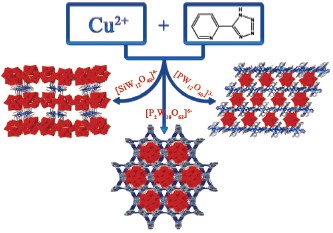| [1] Cheetham, A. M. Science 1994, 264, 794. [2] Pope, M. T.; Müller, A. Angew. Chem., Int. Ed. 1991, 30, 34. [3] Müller, A.; Dillinger, S. Angew. Chem., Int. Ed. 1995, 34, 2328. [4] Zheng, S. T.; Zhang, J.; Yang, G.-Y. Angew. Chem., Int. Ed. 2008, 21, 3909. [5] Li, X. X.; Zheng, S. T.; Zhang, J.; Fang, W. H.; Yang, G.-Y.; Clemente-Juan, J. M. Chem. Eur. J. 2011, 17, 13032. [6] Hagrman, P. J.; Zubieta, J. Angew. Chem., Int. Ed. 1999, 38, 2638. [7] Zheng, S.-T.; Yang, G.-Y. Dalton Trans. 2010, 39, 700. [8] Zhang, C.; Ai, H.-Q.; Ng, S. W. Acta Crystallogr. Sect. E 2006, 2908. [9] Qiu, Y.-E.; Jin, M.-F.; Zhang, X.-L. Acta Crystallogr. E 2007, 2894. [10] Zhang, L. Acta Cryst. E. 2009, 871. [11] Hu, M.; Ma, S. T.; Guo, L. Q.; Fang, S. M. Acta Crystallogr. E 2009, 382. [12] Yang, M. X.; Chen, L. J.; Lin, S. Dalton Trans. 2011, 40, 1866. [13] Liu, M. G.; Zhang, P. P.; Peng, J. Cryst. Growth Des. 2012, 12, 1273. [14] Sha, J. Q.; Tian, A. X.; Yan, P. F. Cryst. Growth Des. 2012, 12, 894. [15] Brown, I. D.; Altermatt, D. Acta Crystallogr. Sect. B 1985, 41, 244. [16] Bassem, S. B.; Ulrich, K. Angew. Chem., Int. Ed. 2007, 46, 6192. [17] Firasat, H.; Robert, W. G.; Colette, B. Chem. Commun. 2009, 328. [18] Bassem, S. B.; Ulrich, K. D.; Louis, N. Inorg. Chem. 2005, 44, 2659. [19] Fan, J.; Ueyama, N. Chem. Eur. J. 2003, 9, 4724. [20] Zhang, K. L.; You, X. Z. Inorg. Chem. Commun. 2004, 7, 584. [21] Lidin, S.; Jacob, M.; Anderson, S. J. Solid State Chem. 1995, 114, 36. [22] Hoi, R. M.; Myunghyun, P. S. Angew. Chem., Int. Ed. 2005, 44, 1261. [23] Sun, Y. Q.; Jun, H.; Xu, Z. T. Chem. Commun. 2007, 4779. [24] Konstantin, V. S.; Louise, N. D. Dalton Trans. 2009, 2926. [25] Enrique, C.; Antonio, J. M. CrystEngComm 2009, 11, 2054. [26] Takayuki, I.; Shin-ichi, M. J. Chem. Soc., Dalton Trans. 2002, 3177. [27] Cao, D. K.; Li, Y. Z.; Zheng, L. M. Dalton Trans. 2008, 5008. [28] Drillon, M.; Carlin, R. L. J. Appl. Phys. 1988, 63, 3551. [29] Takayuki, I.; Shin-ichi, M. J. Chem. Soc., Dalton Trans. 2002, 3177. |
